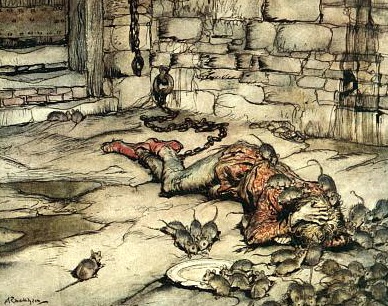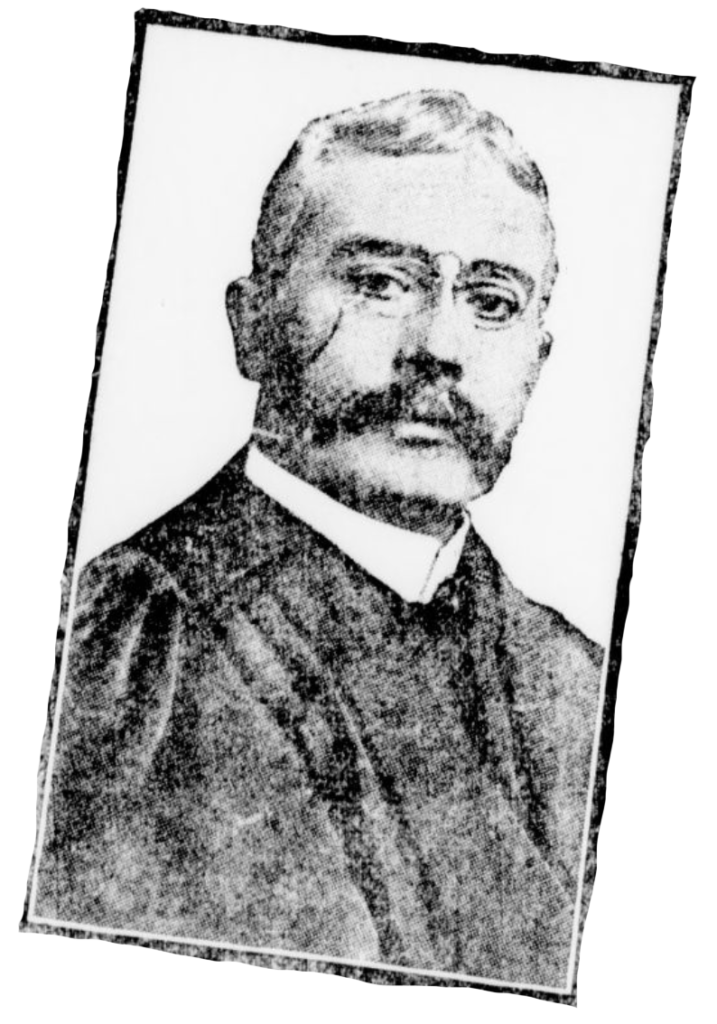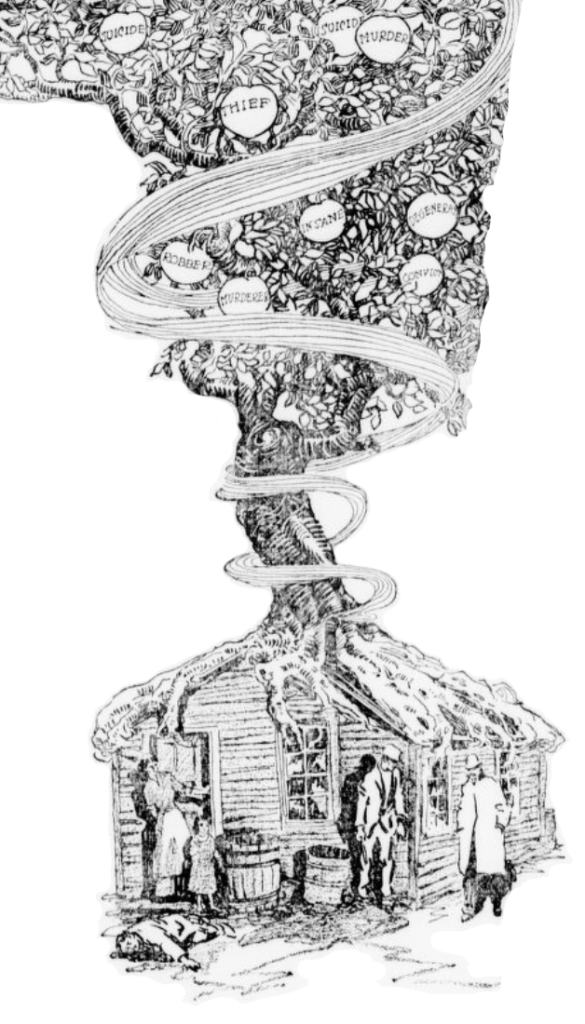
In the article below, published in 1910, is the argument that the only way to remove criminals from society is to give convicted men vasectomies to prevent them from having children.
The reasoning behind this viewpoint is the belief that criminals inherit criminal behaviors from their parents.
The article is long-winded, but it is also an interesting read if you study criminal law.
Heredity Criminality and Its Certain Cure
By Warren W. Foster

“The best way to train a child is to begin with his grandfather” is a remark attributed to that genial philosopher, Dr. Oliver Wendell Holmes, and its wisdom is apparent to all students of the history of crime and criminals.
Whether crime is caused by heredity, environment, or just “happens” is a much-mooted question. The potency of heredity as a causal factor of crime is doubtful to the casual observer, who is of the opinion that all depends on environment. But “atavism,” or the tendency of nature “to return to type,” has come to be recognized generally by scientists and historical and anthropological research undoubtedly prove its existence.
As the criminal stands at the bar and receives his sentence, immuring him behind the prison walls, little is known of his past, even less is learned of his future by the world at large. The average of mankind may know one or two or possibly three criminals, but in all probability does not know the “pedigree” of even one of them. Looking backward, we find that we have outgrown the friends of our youth whose “pedigree” or ancestry we did know, and so cannot trace them further . Thus it follows that whether heredity tends to criminality cannot be ascertained by everyday or common experience. There seems no doubt, however, that it can be determined by statistical research.
Formerly the theory of the criminal law was retribution – an eye for an eye, a tooth for a tooth; he who has sinned must be punished. But the advancement of scientific knowledge has furnished the foundation for a new system of penology, which has, at least upon the statute books, taken the place of the old. The trend of the law for many years has been toward the amelioration of punishment and largely because the nature of the criminal is better understood and it is felt that he is one who needs not so much punishment as proper instruction; and, moreover, because it is now believed that the purpose and intent of our criminal law should be to cure the criminal of his criminal tendencies and restore him to righteous living.
Under the old theory of “responsibility” whoever or whatever sinned was deemed responsible for it and subject to punishment and in the Middle Ages even animals were tried and punished. Invertebrates, also, were not exempt from prosecution. Havelock Ellis tells us in “The Criminal” that in 1454 the bishop of Lausanne initiated legal proceedings against the leeches which infested the water at Berne. The “affair” came before the judges at Berne, the bishop being properly represented. A leech was obtained and brought into the presence of the judges and all leeches, present and absent, were warned to abandon the spots they had the temerity to occupy, three full days being allowed them to evacuate, and a guardian was appointed to watch over their interests and take means for their defense in court. The bishop gained his cause, but the leeches having successfully resisted the decree of the court the bishop finally lost all patience and anathematized them.

Formerly insanity, even with its apparent irresponsibility, was no defense to crime. Before 1789 insanity seems to have been unknown to the French law, although the seventeenth century rule prescribed that no one in the state of “insensate fury” should be punished. The rule, however, proved of little avail. ‘Responsibility” has since received close attention and study and, through the persistent efforts of men of science, its field has steadily enlarged. Schopenhauer says “responsibility supposed that an individual could have acted differently from the way he actually did act.” In a sense, responsibility means that man suffers the consequences of his acts. Man becomes responsible because he lives in society. Society has the right to defend and preserve itself. It recognizes the need of suppressing the criminal and preventing his unlawful acts and it exercises its right to do so.
The progressive feature of the age in penology has been to determine not only whether crime was committed, but whether he who committed it was of such an understanding as to be properly punishable therefor and amenable to disciplinary treatment. Many of the world’s greatest minds have studied this problem, but the first beneficent attempt to minister to the criminal as one “possessed of a devil” or “mind diseased” was made in the state of New York, when the New York State Reformatory at Elmira was created. There the inmates are kept under the strictest of mental and physical discipline; mental arithmetic and Turkish baths are applied together to create a sane mind in a sound body. They are taught that “honesty is the best policy,” the only policy that pays from the practical, worldly point of view. The results have been surprisingly gratifying, only about 20 percent, the friends of that institution claim, of the felons therein incarcerated having returned to ways of crime.
Punishment for crime had its origin in the innate savagery of the human race and is but the transmutation of private revenge into public revenge. At one time or another nearly every fiendish cruel has been tried as a crime cure. “To make the punishment fit the crime,” to quote a popular opera, disregarding the idiosyncrasies of the individual, has been the creative principle of much of our penal law, and such even today is the common opinion of the masses. History, as Lydston points out, shows that when capital punishment was inflicted for slight offenses, as was once the case, instead of decreasing crime it increased it by brutalizing the people, while the éclat of public executions offered a suggestion to the vainglorious criminal of the means whereby he too might occupy for one brief moment the center of the stage. Happily the present tendency of the administration of the criminal law is to ascertain first what is wrong with the individual and then to apply a remedy seemingly likely to cure the wrong. “There are no crimes, only criminals,” said Lacassagne, and that indicates the line along which criminal law and lore must develop if we are to improve mankind.
The level of criminality is rising and has been rising during the whole of the present century throughout the civilized world. In France it has risen several hundred percent; so also, for several kinds of serious crime, in many parts of Germany, while in Spain the number of persons sent to perpetual imprisonment nearly doubled between 1870 and 1883. In the United States the criminal population has increased within 30 years, relatively to the population, by one-third. Criminality is much like insanity. Among primitive races, like insanity, it is rare. But the rising flood of criminality should not beget pessimism; rather should it spur us on to the great task of social betterment, as a profound thinker has observed. Education will not rid us of criminals, for there are already, as we know, many educated criminals. Punishment alone as a specific for crime is a failure. Both education and punishment are but factors in the reformation of the criminal.
To a large extent the child is molded before he is born. There is no invariable fatalism in the influences that work before birth, but it does make a great difference whether a man is well born and starts happily or whether he is heavily handicapped at the outset of the race of life – in a word, whether he is born free from vices of nature or whether the contrary is the fact. There is much evidence to show how greatly the welfare of the child depends on the general physical and emotional health of the parents and that the child’s fate may be determined by some emotional trouble at conception or during pregnancy. Take the remarkable case of Jesse Pomeroy, who as a boy, committed several murders of little children with a brutality that was fiendish, for which he was incarcerated for life in a Massachusetts prison. It was commonly reported and believed that the bloodthirsty impulses of the boy were the direct result of parental influences, the mother, it is said, having when pregnant been much about the shambles where her husband, the boy’s father, was a butcher, and the sight of the blood having thus worked out in the child.
The begetting of children is the highest of all human functions and carries consequences that beggar description. It is well, therefore, to remember that every falling away from health, every new strain or break in man or woman may lay an additional burden on a man or woman yet unborn, perhaps wreck a life or a succession of lives.
Carefully drawn statistics of 4,000 criminals taken from the Elmira reformatory show that drunkenness existed in the parents of 38 percent and probably more. Dr. Christian, of the Elmira reformatory, reports that of 8,000 prisoners received there during the last eight years 19.9 percent were tuberculous, 43.7 percent were affected with some form of mental disease, and that 37.4 percent were mentally defective. Marro finds that on an average 41 percent of the criminals he had examined had a drunken parent, as against 16 percent for normal persons. A large number of criminals investigated by Rossi belonged to criminal families. Dr. Allison, superintendent at the Matteawan State Hospital for the Criminal Insane (New York), is impressed with the frequency with which very serious crimes, especially murder and violent assault, occur in the same family. Morrison reports that among the inmates of English Industrial schools 51 percent are either illegitimates or have one or both parents dead or are the offspring of criminals.
A further proof of the potency of heredity is shown by the investigation of the Rev. Dr. Stocker of Berlin. He traced 834 descendants of two sisters who died in 1825 and found among them 76 who had served 116 years in prison, 164 prostitutes, 106 illegitimate children, 17 pimps, 142 beggars and 64 paupers.
Assuming it, then, as proved, first that the aim of all criminal law and procedure is public protection against crime, and, second, that criminal tendencies as well as virtuous tendencies are transmitted by inheritance, does there not follow, as the night the day, the logical conclusion that criminals ought not to be allowed to propagate their species?
By “criminal” is meant, of course, that class best described as “instinctive criminals,” who have an instinctive propensity to crime and to whom many authorities refer as “born” or “congenital criminals” and who are possessed of an ingrained malignity of disposition.
If, then, it has been shown that heredity is the most potent source of crime and that society should protect itself by preventing the further breeding of criminals, how may society accomplish this?
Various methods have been suggested, among them a rigid regulation of marriage, which shall prohibit the criminal from mating, segregation or colonization of the criminal, and vasectomy. It may be possible by legislation to diminish marriage, but doubtless the effect would be to increase the number of illegitimates, thus augmenting instead of diminishing the “mischief.” The segregation or “colonization” of the criminal, thus making impossible the commingling of the sexes, is approved chiefly by those who have apparently never known of vasectomy. As a matter of fact, it has been tried by the law for a time to which the memory of man runneth not to the contrary – for what else is it than imprisonment within four walls, and has this not already proved its inefficiency?
Coming then to vasectomy, a subject in which an increasing number of state legislatures is becoming interested, the physician furnishes a method of sterilizing the criminal.
This method is in actual operation in at least one state. In March, 1907, the Indiana legislature passed a bill authorizing sterilization.
There appears to be a wonderful unanimity of favoring opinion as to the advisability of the sterilization of criminals and the prevention of their further propagation.
Will public opinion justify the use of this remedy in the case of desperate and incorrigible criminals? While scientists have studied this subject, fraught as it is with appalling public importance, popular ignorance touching it is amazing. It certainly deserves the most careful consideration of all who are interested in the diminution of crime and the uplifting and betterment of the human race.
Source: The Superior times. (Superior, Wis.), 16 April 1910.

